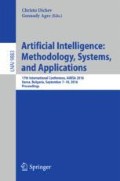Abstract
Clustering algorithms, pattern mining techniques and associated quality metrics emerged as reliable methods for modeling learners’ performance, comprehension and interaction in given educational scenarios. The specificity of available data such as missing values, extreme values or outliers, creates a challenge to extract significant user models from an educational perspective. In this paper we introduce a pattern detection mechanism with-in our data analytics tool based on k-means clustering and on SSE, silhouette, Dunn index and Xi-Beni index quality metrics. Experiments performed on a dataset obtained from our online e-learning platform show that the extracted interaction patterns were representative in classifying learners. Furthermore, the performed monitoring activities created a strong basis for generating automatic feedback to learners in terms of their course participation, while relying on their previous performance. In addition, our analysis introduces automatic triggers that highlight learners who will potentially fail the course, enabling tutors to take timely actions.
References
Koedinger, K.R., Baker, R., Cunningham, K., Skogsholm, A., Leber, B., Stamper, J.: A data repository for the EDM community: the PSLC DataShop. In: Romero, C., Ventura, S., Pechenizkiy, M., Baker, R. (eds.) Handbook of Educational Data Mining. CRC Press, Boca Raton (2010)
Cortez, P., Silva, A.: Using data mining to predict secondary school student performance. In: 5th FUture BUsiness TEChnology Conference (FUBUTEC 2008), Porto, Portugal, pp. 5–12 (2008)
Hall, M., Frank, E., Holmes, G., Pfahringer, B., Reutemann, P., Witten, I.H.: The WEKA data mining software: an update. SIGKDD Explor. 11(1), 10–18 (2009)
Burdescu, D.D., Mihaescu, M.C.: TESYS: e-learning application built on a web platform. In: International Conference on e-Business (ICE-B 2006), Setúbal, Portugal (2006)
MacQueen, J.B.: Some methods for classification and analysis of multivariate observations. In: 5th Berkeley Symposium on Mathematical Statistics and Probability, pp. 281–297. University of California Press, Berkeley (1967)
Dempster, A.P., Laird, N.M., Rubin, D.B.: Maximum likelihood from incomplete data via the EM algorithm. J. Roy. Stat. Soc.: Ser. B (Methodol.) 39(1), 1–38 (1977)
Dasgupta, S., Long, P.M.: Performance guarantees for hierarchical clustering. J. Comput. Syst. Sci. 70(4), 555–569 (2005)
Ester, M., Kriegel, H.-P., Sander, J., Xu, X.: A density-based algorithm for discovering clusters in large spatial databases with noise. In: International Conference on Knowledge Discovery and Data Mining (KDD-96), pp. 226–231. AAAI Press (1996)
Jackson, D.A., Somers, K.M., Harvey, H.H.: Similarity coefficients: measures of co-occurrence and association or simply measures of occurrence? Am. Nat. 133(3), 436–453 (1989)
Sneath, P.H.A., Sokal, R.R.: Principles of Numerical Taxonomy. W.H. Freeman, San Francisco (1963)
Rousseeuw, P.J.: Silhouettes: a graphical aid to the interpretation and validation of cluster analysis. J. Comput. Appl. Math. 20, 53–65 (1987)
Kaufman, L., Rousseeuw, P.J.: Finding Groups in Data. An Introduction to Cluster Analysis. Wiley-Interscience, New York (1990)
Jugo, I., Kovačić, B., Tijan, E.: Cluster analysis of student activity in a web-based intelligent tutoring system. Sci. J. Maritime Res. 29, 75–83 (2015)
Hompes, B.F.A., Verbeek, H.M.W., van der Aalst, W.M.P.: Finding suitable activity clusters for decomposed process discovery. In: Ceravolo, P., Russo, B., Accorsi, R. (eds.) SIMPDA 2014. LNBIP, vol. 237, pp. 32–57. Springer, Heidelberg (2015). doi:10.1007/978-3-319-27243-6_2
Meilă, M.: Comparing clusterings by the variation of information. In: Schölkopf, B., Warmuth, M.K. (eds.) COLT/Kernel 2003. LNCS (LNAI), vol. 2777, pp. 173–187. Springer, Heidelberg (2003)
Patrikainen, A., Meilă, M.: Comparing subspace clusterings. IEEE Trans. Knowl. Data Eng. 18(7), 902–916 (2006)
Wallace, D.L.: Comment. J. Am. Stat. Assoc. 383, 569–576 (1983)
Fowlkes, E.B., Mallows, C.L.: A method for comparing two hierarchical clusterings. J. Am. Stat. Assoc. 383, 553–569 (1983)
Rand, W.M.: Objective criteria for the evaluation of clustering methods. J. Am. Stat. Assoc. 66, 846–850 (1971)
Mirkin, B.: Mathematical Classification and Clustering. Kluwer Academic Press, Boston (1996)
Stein, B., Meyer zu Eissen, S., Wißbrock, F.: On cluster validity and the information need of users. In: 3rd IASTED International Conference on Artificial Intelligence and Applications (AIA 2003), Benalmádena, Spain, pp. 404–413 (2003)
Ben-David, S., Ackerman, M.: Measures of clustering quality: a working set of axioms for clustering. In: Neural Information Processing Systems Conference (NIPS 2008), pp. 121–128 (2009)
Bogarín, A., Romero, C., Cerezo, R., Sánchez-Santillán, M.: Clustering for improving educational process mining. In: 4th International Conference on Learning Analytics and Knowledge (LAK 2014), pp. 11–15. ACM, New York (2014)
Li, C., Yoo, J.: Modeling student online learning using clustering. In: 44th Annual Southeast Regional Conference (ACM-SE 44), pp. 186–191. ACM, New York (2006)
Bian, H.: Clustering student learning activity data. In: 3rd International Conference on Educational Data Mining, Pittsburgh, PA, pp. 277–278 (2010)
Acknowledgements
The work presented in this paper was partially funded by the FP7 2008-212578 LTfLL project and by the EC H2020 project RAGE (Realising and Applied Gaming Eco-System) http://www.rageproject.eu/ Grant agreement No. 644187.
Author information
Authors and Affiliations
Corresponding author
Editor information
Editors and Affiliations
Rights and permissions
Copyright information
© 2016 Springer International Publishing Switzerland
About this paper
Cite this paper
Mihăescu, M.C., Tănasie, A.V., Dascalu, M., Trausan-Matu, S. (2016). Extracting Patterns from Educational Traces via Clustering and Associated Quality Metrics. In: Dichev, C., Agre, G. (eds) Artificial Intelligence: Methodology, Systems, and Applications. AIMSA 2016. Lecture Notes in Computer Science(), vol 9883. Springer, Cham. https://doi.org/10.1007/978-3-319-44748-3_11
Download citation
DOI: https://doi.org/10.1007/978-3-319-44748-3_11
Published:
Publisher Name: Springer, Cham
Print ISBN: 978-3-319-44747-6
Online ISBN: 978-3-319-44748-3
eBook Packages: Computer ScienceComputer Science (R0)

